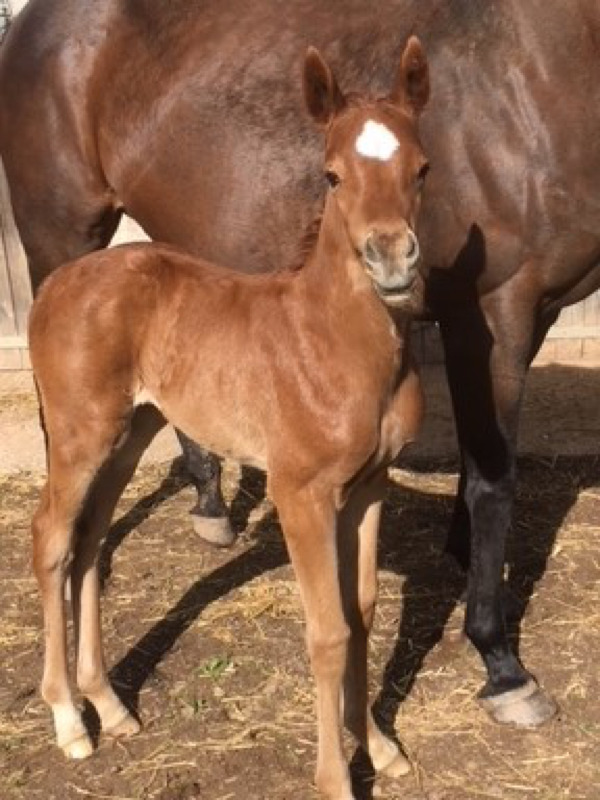Caroline Blake from Torch Equine Vets in North Devon tells us about a case of sudden collapse in a neonatal foal.
Last Friday’s night on-call shift began with an emergency visit to a neonatal filly that had suddenly collapsed. Her mum, Patsy had delivered her the night before and all had seemed well.
The following day, Patsy and her foal spent the afternoon in the paddock soaking up some warm sunshine, while their exhausted owner took a well-earned break for a couple of hours, having camped outside her stable for a week in his truck!
However trouble was brewing. On the owner’s return, the day-old foal was found in a collapsed heap with her desperate mother watching over in confusion.
One phone call later and I was soon accelerating towards the setting sun, trying hard not to break any speed limits.
On arrival, it soon became clear that this was a very sick foal and I was going to have act quickly and effectively to save her. It was going to be a very long night.
Jumping into action
The foal was unable to stand, lying flat on her side. Her gum membranes were brick red, and her breathing was fast and laboured.
Losing awareness of her surroundings, her heart was racing while her body temperature was soaring.
The foal’s condition had deteriorated from normality to collapse in a matter of hours.
I immediately placed an intravenous catheter into her jugular vein, but before giving any medication I took some blood samples that would give me valuable information.
I started to give intravenous fluids, with antibiotics, anti-inflammatories and tetanus antitoxin.
In the meantime the blood results confirmed my fears.
The cause of collapse
The foal’s immunoglobulin (IgG) levels were very low meaning she hadn’t received the vital antibodies in her dam’s colostrum to protect her against infection. Her white blood cell count was consistent with acute infection.
Foals are not born with well-developed immunity to the germs in the outside word. This crucial immunity is provided in the form of antibodies in the rich yellow colostrum (or first milk).
It’s essential that the foal receives this milk within the first four hours of life. After this time, the ability of the foal’s gut to absorb these large protein molecules reduces.
In this case, Patsy had been running milk from her udder for a few days prior to foaling, and it would seem that despite feeding well from birth, the best of the colostrum had been lost before her foal had chance to benefit.
As a result, this day-old foal was unable to cope with the barrage of new challenges in the world outside the uterus, causing acute infection and resultant collapse.
Treatment
To restore the antibody levels in the blood, an immediate plasma transfusion was required. We keep a supply of frozen plasma in stock for such cases.
The foal’s condition continued to deteriorate rapidly. She was now having severe seizures, with tetanic convulsions contorting her tiny body; sweating profusely with her head arched back and limbs rigidly extended.
Seizures occur in neonatal foals as the barrier between the bloodstream and brain is not fully formed meaning acute infection can quickly lead to inflammation around the brain and hence neurological signs.
I gave repeated injections of intravenous diazepam to control the seizures, and started a slow plasma transfusion.
Keeping the foal warm with blankets and cushioning under her head was vital to prevent trauma.
The long night followed, which saw me continuing to monitor the foal during and after the plasma transfusion, and controlling the seizures. Thankfully, these gradually became less severe and frequent, and then eventually stopped.
As the foal could not suck, Patsy‘s udder was soon overflowing with milk. This was collected and fed to the foal via a small stomach tube to ensure that she was still getting adequate nutrition.
The morning after the night before

The foal the morning after collapse; note the trauma around eyes due to convulsions and her sleepy expression with low head carriage
In the hours of early morning, the foal’s condition stabilised and she was left to sleep while we humans also shut our eyes, albeit for a short while.
The spring sunrise brought with it a sleepy and rather traumatised foal, but with help she was able to stand and suck.
As sunrise gave way to another bright day, the foal too became brighter and stronger with each hour.
I repeated another intravenous fluid infusion and topped up her antibiotics and anti-inflammatories.
Happily, she became stronger and stronger, and was able to stand and suck on her own, meaning she didn’t need any further stomach tubing.
I’m delighted to say that the foal never looked back, going from strength to strength over the next few days.
The photo above shows her at 11 days old, with a complete return to normal, spritely foal behaviour.
My weekend duties continued to be very busy with a horse that had trodden on a two-inch roofing nail, a difficult foaling, a horse with a puncture wound near the tendon-sheath, and an old mare with an acute asthma attack.

The photo above shows her at 11 days old, with a complete return to normal, spritely foal behaviour.
A stark reminder of the challenges of being an equine vet – a job that could never be described as dull!
Don’t miss the latest issue of Your Horse Magazine, jam-packed with training and veterinary advice, horse-care tips and the latest equestrian products available on shop shelves, on sale now.










